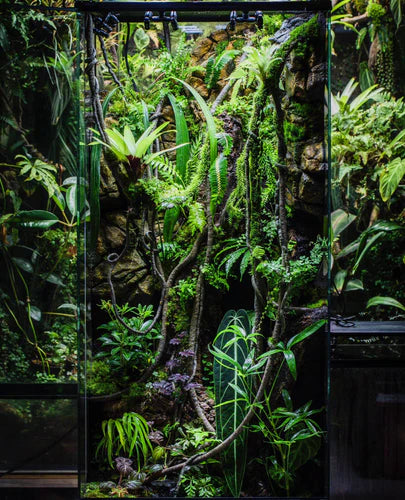1. Aquatic Plants
Java Fern (Microsorum pteropus):
- Description: Java Fern is a hardy, low-maintenance plant with broad, dark green leaves.
- Care Requirements: It thrives in low to moderate light and can be attached to rocks or driftwood.
- Benefits: Provides excellent cover for fish and helps control algae growth.
Anubias (Anubias barteri):
- Description: Anubias is another hardy plant, known for its thick, durable leaves.
- Care Requirements: Prefers low to moderate light and can be attached to substrate, rocks, or wood.
- Benefits: Enhances the tank’s structure and offers hiding spots for fish.
Amazon Sword (Echinodorus grisebachii):
- Description: Amazon Sword has large, sword-shaped leaves that can grow up to 20 inches tall.
- Care Requirements: Requires moderate to high light and nutrient-rich substrate.
- Benefits: Acts as a focal point in the tank and provides excellent shelter for fish.
2. Terrestrial Plants
Bromeliads:
- Description: Bromeliads are vibrant plants that can thrive on driftwood or rocks above the waterline.
- Care Requirements: They need high humidity and indirect light.
- Benefits: Adds vertical interest and helps maintain humidity levels in the tank.
Ferns (Nephrolepis exaltata):
- Description: Ferns are popular for their feathery fronds and lush appearance.
- Care Requirements: Thrive in high humidity and low to moderate light.
- Benefits: Improves air quality and provides a natural look to the tank.
Mosses (Taxiphyllum barbieri):
- Description: Java Moss and other mosses are excellent for creating a carpet-like effect.
- Care Requirements: Tolerate a wide range of conditions but prefer low to moderate light.
- Benefits: Provides breeding grounds for fish and helps control nitrates.
3. Plant Care Tips
- Lighting: Use full-spectrum LED lights to support plant growth. Adjust the intensity and duration based on the needs of your plants.
- Fertilization: Regularly use liquid fertilizers and root tabs to supply essential nutrients. Monitor for any signs of deficiencies.
- CO2 Injection: Consider adding CO2 to the tank to enhance plant growth, especially for more demanding species.
- Pruning: Regularly trim plants to prevent overgrowth and maintain a healthy environment. Remove dead or decaying leaves promptly.
- Water Parameters: Maintain stable water conditions with appropriate pH, hardness, and temperature levels suited to your plant species.
4. Creating a Balanced Ecosystem
- Layering Plants: Use a mix of foreground, midground, and background plants to create depth and visual interest.
- Compatibility: Choose plants that are compatible with your tank’s inhabitants. Avoid plants that may be toxic or harmful to fish and other organisms.
- Natural Filtration: Plants help in natural filtration by absorbing nitrates and other waste products, contributing to a healthier tank environment.
Conclusion:
Choosing the right plants for your rainforest tank is crucial for creating a vibrant and thriving ecosystem. By selecting a variety of aquatic and terrestrial plants and providing proper care, you can enjoy the beauty and benefits of a well-balanced rainforest tank. Stay tuned for more tips and guides on maintaining and enhancing your aquarium setup.


Share:
Introduction to Rainforest Tank Breeding
Moss Bottle-Micro-landscape Ecological Bottle